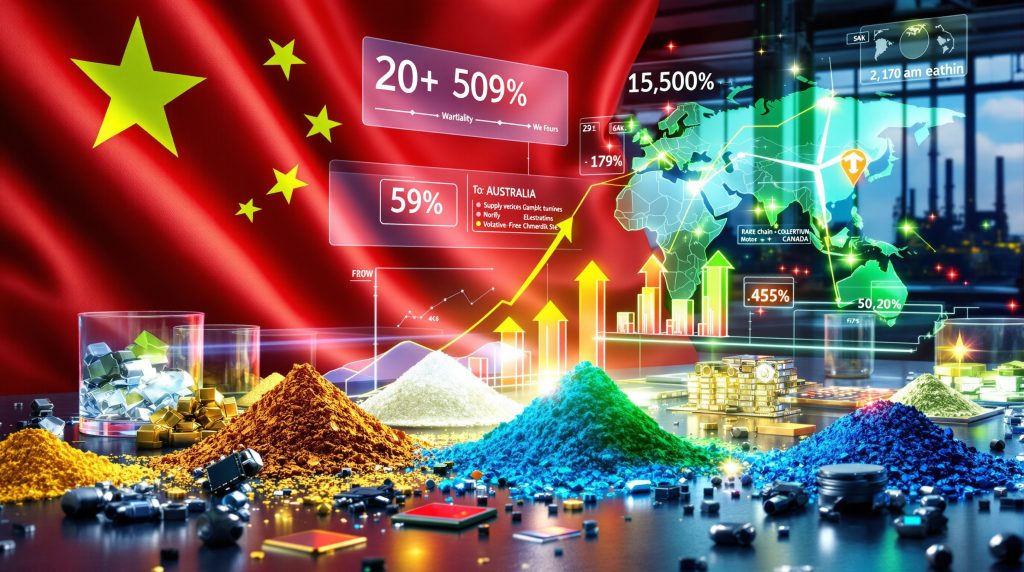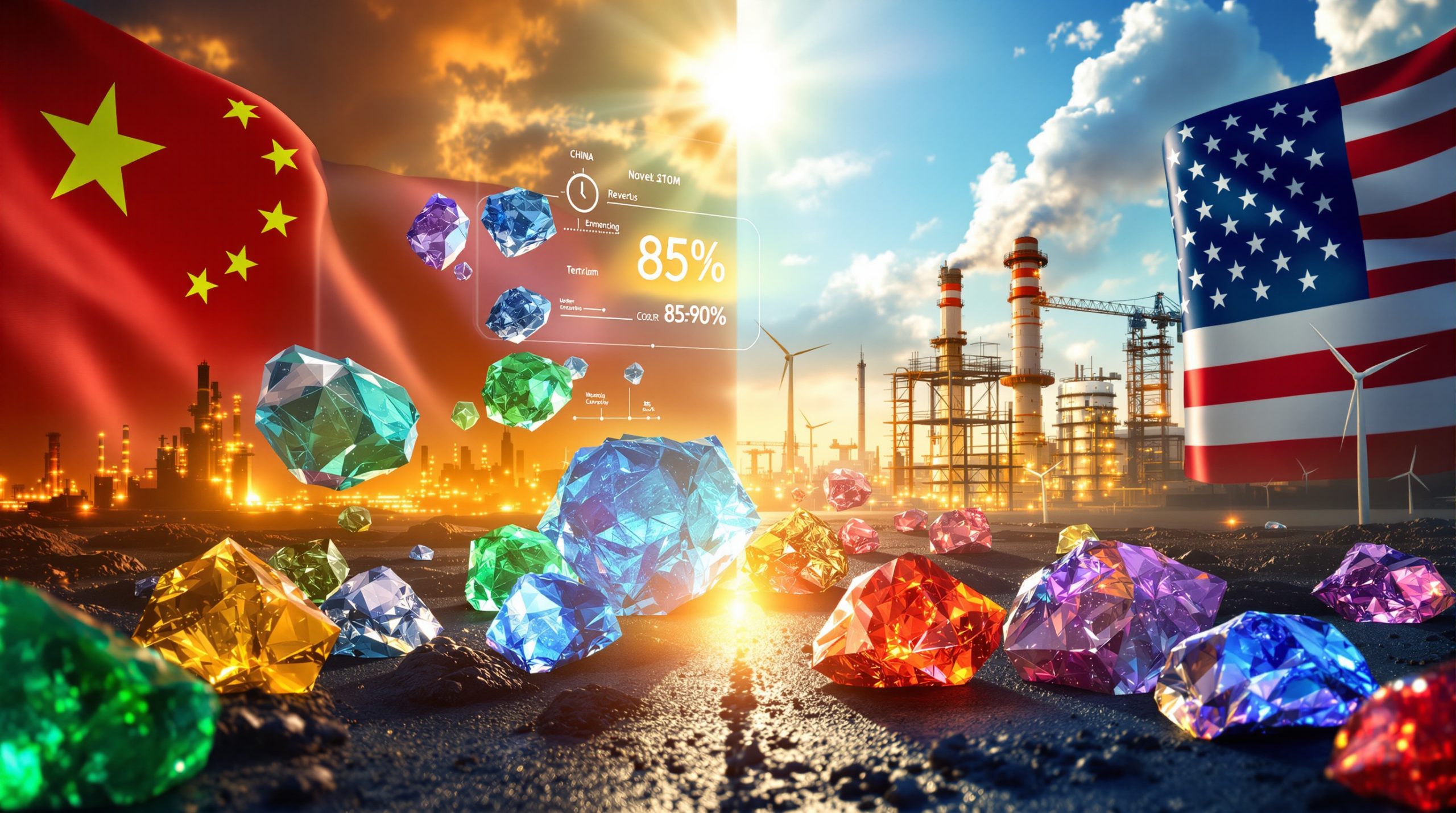China's dominance over rare earth elements has reached a critical juncture in 2025, with Beijing implementing comprehensive export restrictions that are fundamentally altering global manufacturing and technology sectors. These materials, essential for everything from smartphone screens to military defense systems, have become powerful geopolitical tools reshaping international trade dynamics.
The implementation of rare earth export curbs has created unprecedented supply chain vulnerabilities across multiple industries, forcing companies and nations to reassess their strategic dependencies. According to recent diplomatic developments, European Council President Antonio Costa has confirmed that high-level Chinese officials are scheduled to visit Brussels in the coming weeks to discuss Beijing's expanded export controls on critical raw materials.
What Are Rare Earth Elements and Why Do They Matter?
Rare earth elements represent a group of 17 metallic elements that, despite their name, are relatively abundant in Earth's crust but extremely difficult to extract and process economically. These materials possess unique magnetic, luminescent, and electrochemical properties that make them irreplaceable in modern technology applications.
Key Applications Across Industries:
• Electric vehicle motors requiring neodymium-iron-boron permanent magnets
• Wind turbine generators utilizing dysprosium for high-temperature stability
• Semiconductor manufacturing components incorporating yttrium and europium
• Military radar and missile guidance systems using samarium-cobalt magnets
• Medical imaging equipment and laser systems employing terbium compounds
Global Supply Chain Dependencies
China currently processes more than 90% of the world's refined rare earth materials, creating unprecedented vulnerability for technology-dependent economies worldwide. This concentration stems from decades of strategic investment in mining infrastructure and processing capabilities that international competitors have struggled to replicate due to environmental concerns, technical complexity, and significant capital requirements.
The processing of rare earth elements involves multiple stages of chemical separation using acids and solvents, requiring specialized facilities and expertise that China has developed over several decades. Furthermore, global rare earth reserves are concentrated in specific geographical regions, creating additional supply vulnerabilities. Alternative producers face substantial barriers including environmental regulations, community opposition, and the need for billion-dollar processing infrastructure investments.
How China's 2025 Export Controls Differ From Previous Restrictions
The October 2025 regulations represent a significant escalation from previous rare earth export quotas, extending control mechanisms far beyond traditional boundaries. These new measures encompass not only raw materials but also processing technologies, equipment, and downstream products containing Chinese rare earth content.
Expanded Material Coverage
The current restrictions extend to multiple categories previously exempt from export controls:
• Lithium-ion battery components and synthetic graphite materials
• Rare earth processing equipment and extraction technologies
• Superhard materials including tungsten carbide and diamond tools
• Dual-use items with both civilian and military applications
Extraterritorial Enforcement Mechanisms
For the first time, China is applying controls to products manufactured outside its borders if they contain Chinese rare earth content above a 0.1% value threshold or utilise Chinese extraction technologies. This represents a fundamental shift in enforcement scope, creating compliance challenges for global manufacturers with complex supply chains.
Implementation Timeline and Compliance Requirements
| Control Category | Effective Date | Key Requirements |
|---|---|---|
| Mining Technology | November 8, 2025 | Export licensing for specialised equipment |
| Processing Materials | December 1, 2025 | Content declaration mandates |
| Dual-Use Items | Immediate | Military/civilian use identification |
| Foreign Products | December 1, 2025 | Supply chain tracking obligations |
Industries Facing the Greatest Disruption
Electric Vehicle Manufacturing Crisis
The automotive sector faces particularly severe challenges as electric vehicle production relies heavily on rare earth permanent magnets for motor efficiency. Industry analysts report that major EV manufacturers are operating with 12-18 month supply buffers before facing critical shortages that could halt production lines.
The situation has become more acute as China's export restrictions coincide with global EV adoption targets. European automakers, in particular, are scrambling to secure alternative suppliers while simultaneously investing in magnet recycling technologies to recover neodymium and dysprosium from end-of-life vehicles.
Renewable Energy Infrastructure Vulnerabilities
Wind turbine manufacturers depend on substantial quantities of neodymium and dysprosium for efficient operation of direct-drive generators. A typical 3-megawatt wind turbine requires approximately 600 kilograms of rare earth materials, making large-scale renewable energy projects vulnerable to supply disruptions.
Solar panel manufacturers also face challenges as certain photovoltaic cell technologies require europium and terbium for optimal light conversion efficiency. The timing of these restrictions coincides with aggressive renewable energy deployment schedules across multiple continents, highlighting the importance of critical minerals energy transition strategies.
Defense and Aerospace Sectors
Military applications represent the most critical dependencies, with guided missile systems requiring samarium-cobalt magnets that maintain performance under extreme temperature variations. Advanced fighter aircraft utilise rare earth elements in radar systems, electronic warfare equipment, and precision guidance components that have limited alternative material options.
Consequently, the defence mineral supply chain faces unprecedented vulnerabilities that require immediate strategic attention and alternative sourcing initiatives.
Global Powers' Response to Export Restrictions
United States Strategic Initiatives
The Trump administration has responded aggressively to China's rare earth export curbs with multifaceted countermeasures. President Trump has threatened 100% tariffs on Chinese goods if restrictions continue, while simultaneously accelerating domestic rare earth processing facility development through the Defense Production Act.
Key initiatives include:
• Strengthening partnerships with Australia and Canada for alternative supply sources
• Investing $3.2 billion in domestic rare earth mining and processing infrastructure
• Establishing strategic reserves for critical defence applications
• Funding recycling technologies to recover materials from electronic waste streams
European Union Diversification Efforts
European leaders are pursuing comprehensive strategies to reduce dependency on Chinese rare earths through the Critical Raw Materials Act. Costa's confirmation of upcoming high-level discussions with Chinese officials reflects the EU's diplomatic approach while simultaneously building alternative supply networks.
The European strategy encompasses:
• Negotiating trade agreements with Malaysia, Thailand, and the Philippines
• Funding rare earth exploration projects in Greenland and African nations
• Establishing strategic material reserves equivalent to 12 months of consumption
• Developing circular economy approaches to material recovery and reuse
However, the establishment of a critical raw materials facility remains a key priority for ensuring long-term supply security across Europe.
India's Self-Reliance Campaign
Despite announcing a ₹7,300 crore scheme to boost domestic rare earth production, India faces significant technical challenges. The country possesses substantial thorium-rich rare earth deposits in Odisha and Kerala but lacks the processing expertise and environmental clearances necessary for large-scale operations.
India's strategy includes partnerships with international mining companies and technology transfer agreements, though implementation timelines extend beyond immediate supply crisis resolution periods.
Economic Implications of Supply Chain Disruption
Price Volatility and Market Dynamics
Rare earth prices have experienced unprecedented volatility since China's export controls announcement, with critical elements seeing dramatic price increases:
• Neodymium oxide prices increased 340% from baseline levels
• Dysprosium oxide costs rose 280% due to supply concerns
• Terbium prices fluctuated by over 400% within quarterly periods
This volatility creates significant planning difficulties for manufacturers operating on thin margins and threatens long-term contract stability across technology sectors.
Manufacturing Cost Escalation
Companies are reporting substantial cost increases as they seek alternative suppliers or invest in strategic inventory buffers. Tesla, for instance, has indicated that rare earth shortages could increase Model Y production costs by 15-20% if alternative materials cannot be sourced effectively.
Investment Flow Redirection
Capital markets are rapidly redirecting funds toward rare earth exploration and processing projects outside China. Mining companies in Australia, Canada, and the United States have received over $12 billion in committed funding for development initiatives since the export restrictions were announced.
Emerging Alternative Supply Sources
Australia's Resource Development
Australia possesses the world's sixth-largest rare earth reserves and is aggressively expanding processing capabilities to compete with Chinese dominance. Major projects demonstrating significant progress include:
• Mount Weld operations producing 22,000 tonnes annually of mixed rare earth concentrates
• Nolans Project development targeting 14,000 tonnes annual production capacity
• Browns Range heavy rare earth extraction focusing on dysprosium and terbium
North American Development Projects
The Mountain Pass mine in California has resumed full-scale operations with annual production capacity of 38,000 tonnes of rare earth concentrate. Canadian exploration companies are advancing multiple projects in Quebec's Grenville Province and Northwest Territories, with combined potential production exceeding 50,000 tonnes annually by 2028.
Mexico is emerging as a processing hub for North American supply chains, offering lower labour costs and established mining infrastructure for downstream rare earth refinement operations.
African Mining Opportunities
Several African nations are developing rare earth resources through international partnerships:
• Tanzania's Ngualla project targeting 8,500 tonnes annual neodymium and praseodymium production
• South Africa's Steenkampskraal mine focusing on heavy rare earths with 2,800 tonnes annual capacity
• Madagascar's expansion beyond nickel to include rare earth extraction from laterite deposits
Navigating Supply Chain Challenges
Risk Mitigation Strategies
Companies successfully managing rare earth supply disruptions are implementing comprehensive risk management frameworks:
• Diversifying supplier networks across minimum three geographic regions
• Building strategic inventory reserves equivalent to 6-9 months consumption
• Investing in urban mining and recycling technologies for material recovery
• Developing alternative material technologies where technically feasible
In addition, understanding the broader geopolitical mining landscape is crucial for effective long-term planning and risk assessment.
Compliance and Legal Considerations
Organisations must now track Chinese-origin content throughout their supply chains and obtain appropriate export licences. This requires substantial investment in supply chain transparency systems, with compliance costs estimated at 2-4% of annual procurement budgets for technology manufacturers.
Legal frameworks are evolving rapidly, with potential penalties for non-compliance including market access restrictions and financial sanctions that could exceed $100 million for major corporations.
Long-term Planning Approaches
Successful navigation of rare earth supply challenges requires strategic planning horizons extending 10-15 years beyond immediate crisis resolution:
• Securing long-term supply contracts with non-Chinese producers at premium pricing
• Investing in research and development for material substitutes and efficiency improvements
• Building closer relationships with government agencies managing national strategic reserves
• Participating in industry consortiums for collective bargaining power and risk sharing
Future Outlook for Rare Earth Markets
Technology Innovation Drivers
Research into alternative materials and more efficient recycling processes is accelerating with unprecedented funding levels. Breakthrough technologies in permanent magnet alternatives using iron-nitride compounds could potentially reduce rare earth dependencies in electric vehicle applications by 30-40% within the next decade.
Advanced separation technologies utilising ionic liquids and membrane processes promise to reduce rare earth processing costs while minimising environmental impacts, potentially making smaller-scale operations economically viable.
Geopolitical Stability Factors
The resolution of trade tensions between China and major consuming nations will significantly impact long-term market dynamics. Diplomatic negotiations currently underway in Brussels and other venues could result in modified export restrictions that balance China's strategic interests with global supply chain stability requirements.
Supply Chain Resilience Building
Current crisis conditions are driving unprecedented investment in supply chain diversification initiatives. While achieving complete independence from Chinese rare earths may require 20-30 years, meaningful progress toward balanced global supply networks is already demonstrating measurable results.
"The fundamental challenge lies not merely in finding alternative sources, but in developing the entire value chain from mining through processing to end-user applications while maintaining cost competitiveness and environmental sustainability standards."
Industry experts project that global rare earth production outside China will increase by 300-400% over the next decade, though this expansion must overcome significant technical, financial, and regulatory hurdles that have historically favoured Chinese operations.
The transformation of rare earth markets represents more than a simple supply chain adjustment; it embodies a fundamental shift toward resource security that will reshape global manufacturing and technology development patterns for decades to come. Success in this new environment requires proactive risk management, strategic partnerships, and long-term commitment to supply chain diversification that extends far beyond immediate crisis response measures.
Ready to Capitalise on China's Rare Earth Restrictions?
Discovery Alert's proprietary Discovery IQ model delivers instant alerts on significant mineral discoveries across critical materials sectors, including rare earth elements and other strategic commodities essential for modern technology. With supply chain disruptions creating unprecedented opportunities in alternative mining projects, explore Discovery Alert's historic discoveries to understand how major mineral finds can generate substantial returns, then begin your 30-day free trial to position yourself ahead of these rapidly evolving markets.




